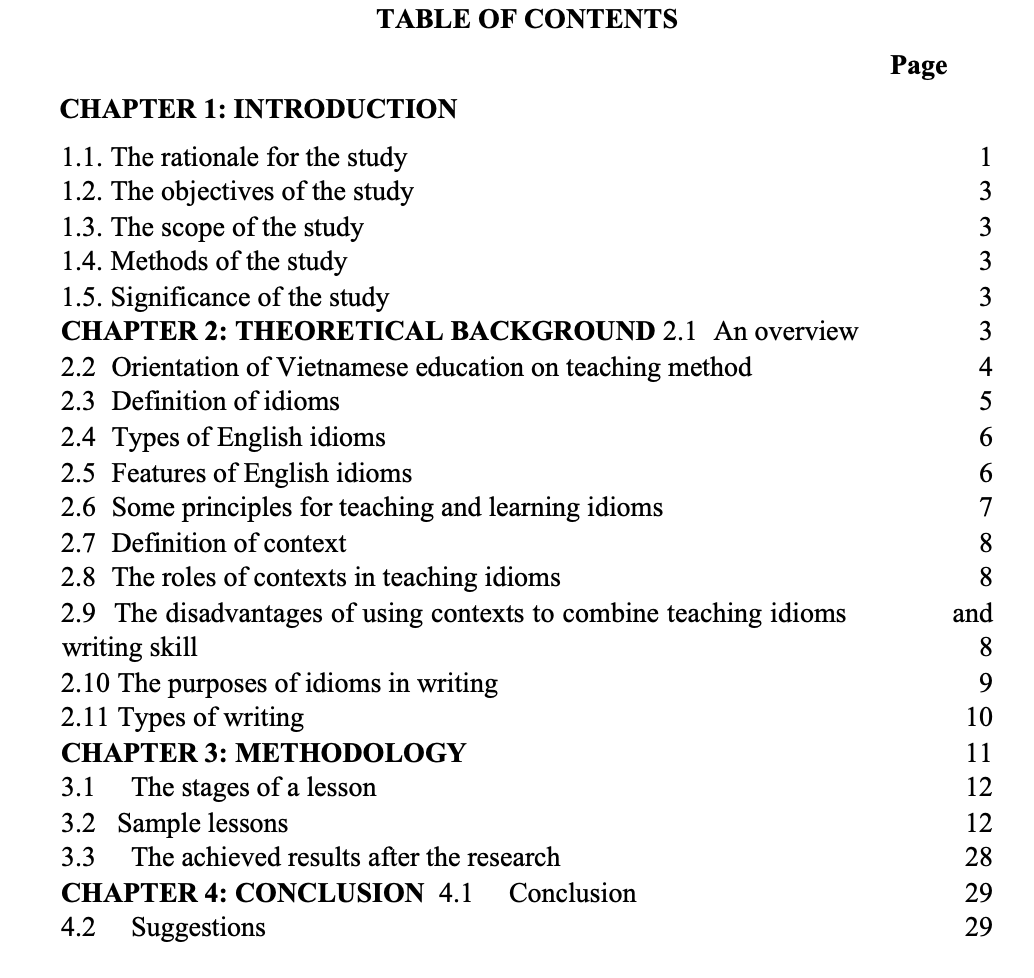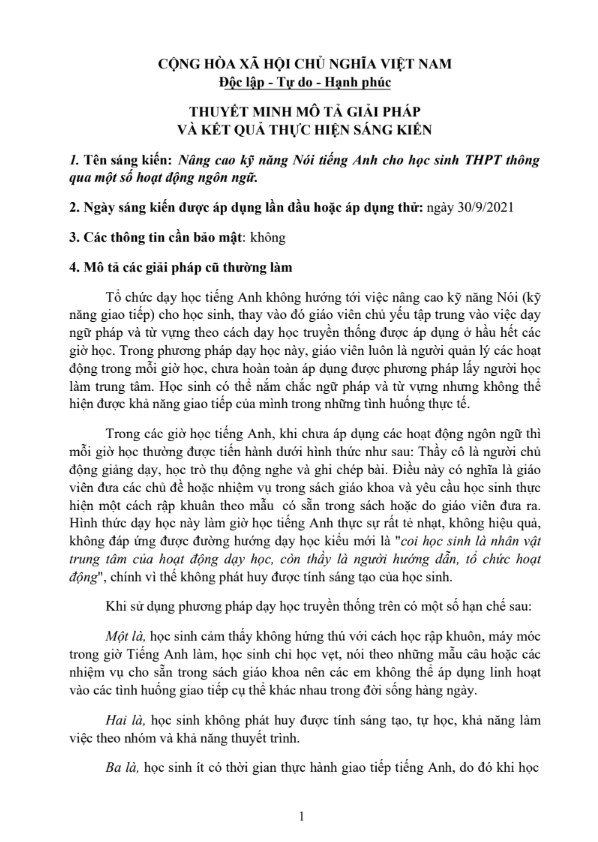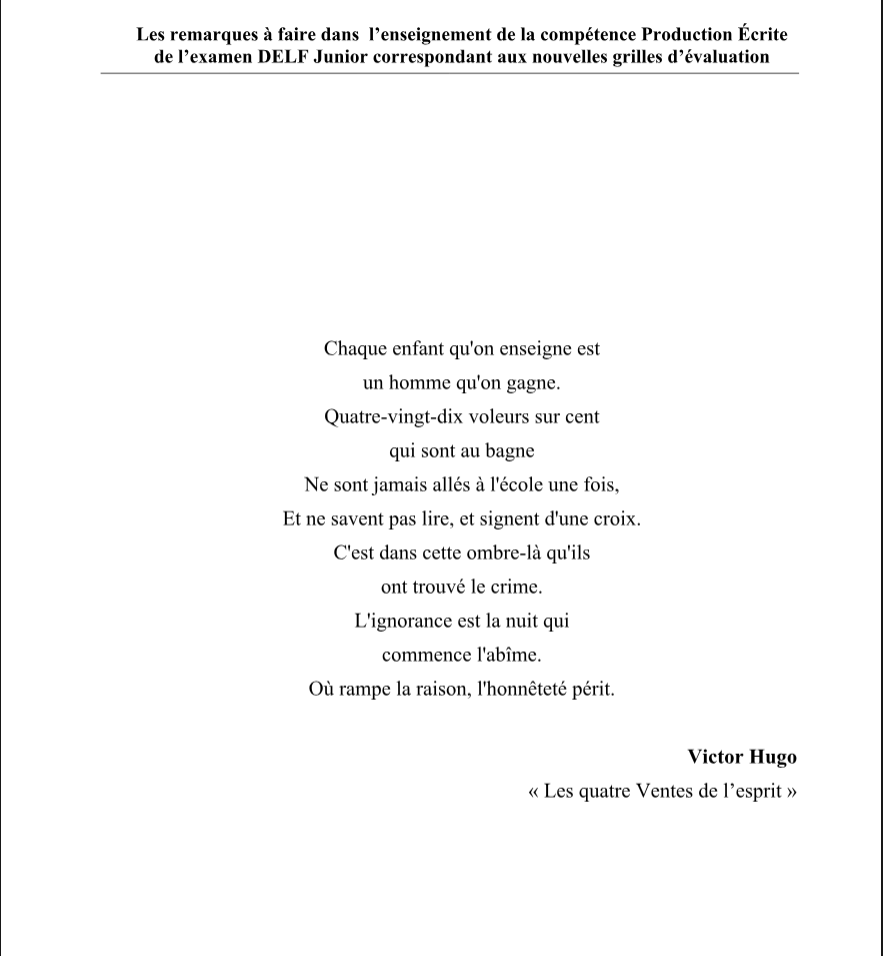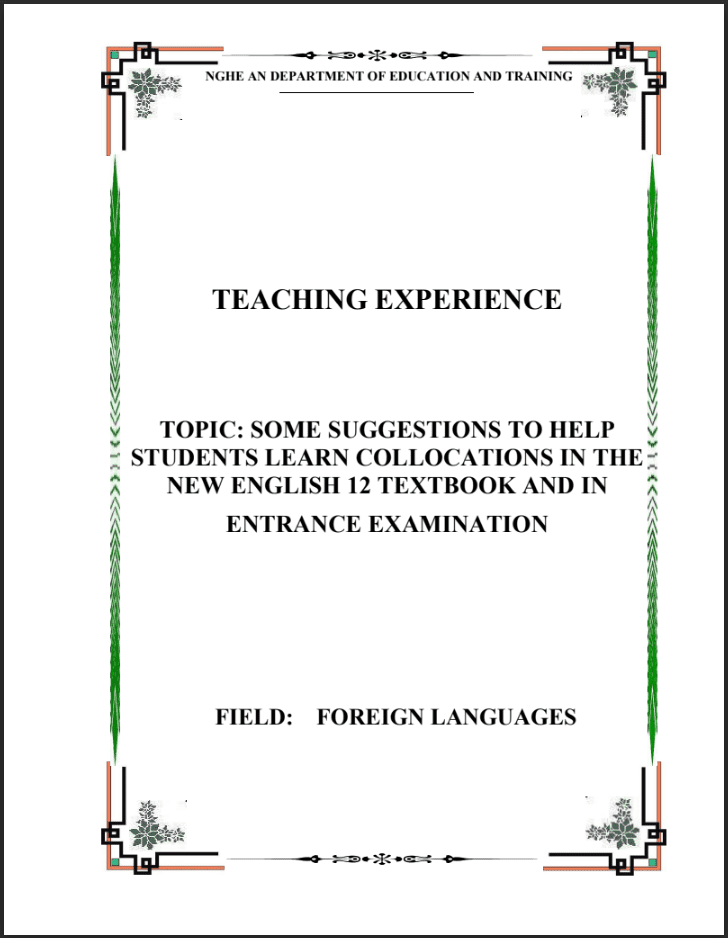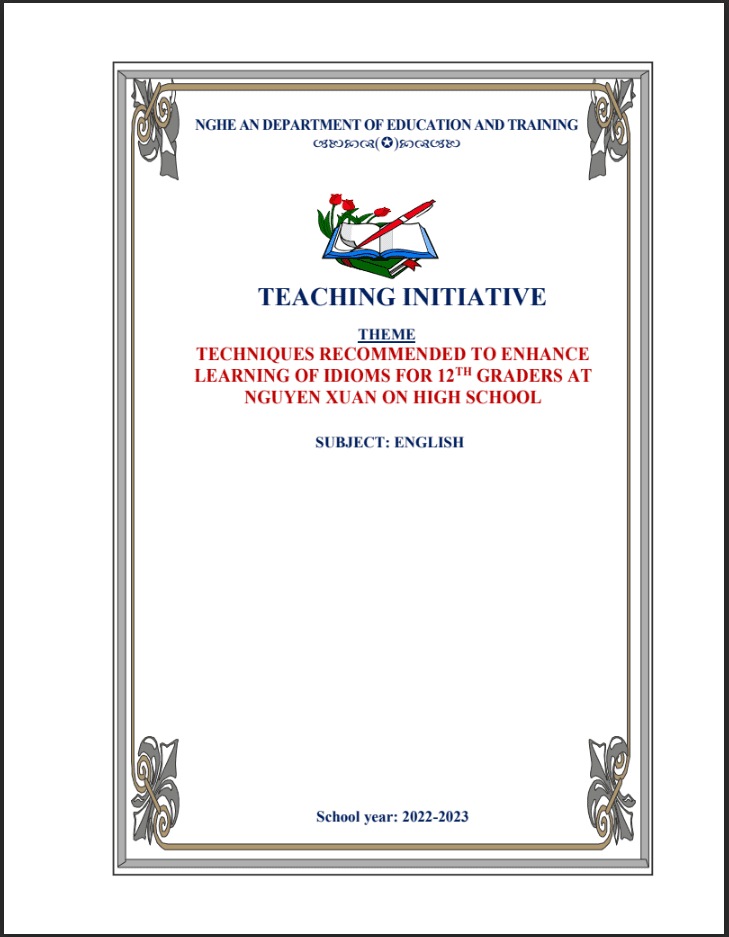SKKN Combining teaching English idioms and writing skill by using contexts
- Mã tài liệu: MP0041 Copy
| Môn: | Tiếng anh |
| Lớp: | 11 |
| Bộ sách: | |
| Lượt xem: | 907 |
| Lượt tải: | 4 |
| Số trang: | 45 |
| Tác giả: | Bùi Thị Hoa |
| Trình độ chuyên môn: | Cử nhân đại học |
| Đơn vị công tác: | THPT Con Cuông |
| Năm viết: | 2021-2022 |
| Số trang: | 45 |
| Tác giả: | Bùi Thị Hoa |
| Trình độ chuyên môn: | Cử nhân đại học |
| Đơn vị công tác: | THPT Con Cuông |
| Năm viết: | 2021-2022 |
Sáng kiến kinh nghiệm “SKKN Combining teaching English idioms and writing skill by using contexts” triển khai gồm các biện pháp nổi bật sau:
Step 1: Make a decision having in view the unfamiliar words of speech,
Step 2: Glance instantly at the contextual words,
Step 3: Look at the vast context of the word,
Step 4: Presume (guessing)
Step 5: Verify the guessing.
Mô tả sản phẩm
CHAPTER 1: INTRODUCTION
1.1 The rationale for the study
Learning the English language has become a necessity in many aspects so has become teaching it. Apart from learning grammar, this includes learning and teaching vocabulary. Building vocabulary helps Vietnamese students in an ESL classroom and outside of it speak more fluently. There is still a problem when it comes to speaking English fluently: students’ ability to understand native speakers or when reading an authentic book or any other written material meant for native speakers. One of the biggest challenges is understanding idioms and anything that has idiomatic meaning. Therefore learning and teaching idioms are as important as learning and teaching other parts of the English language.
Idioms are frequently used in both formal and informal, spoken and written discourse. They are common in movies, on television, in journalism, in books and literature, and in advertising, as well as in everyday life. According to Polio, Barlow, and Fine (1977), most English speakers utter about 7,000 idioms per week. This means that about four idiomatic expressions are produced in every minute of speech.
Erman and Warren calculated that “idioms make up a large portion of any discourse, constituting 58.6% of spoken English and 52.3% of written English” (Erman & Warren, 2000). Thus, idiomatic expressions create a significant portion of our everyday communication and they often appear in listening or reading tests. It can be difficult to learn and understand their meanings without understanding the proper context in which they are used. This is because the meaning of an idiom is not always obvious or literal.
Learning idioms is a significant way of contributing to the development of axiology in the sense of cross-cultural relations, because the students exposed to these already-made language structures, which are full of culture and wisdom from their native context, will learn to respect and understand the culture from where the idioms are coming, without losing their cultural values. They will enrich their own culture by assuming the most outstanding values of the target language. Moreover, to have a good preparation for the exams such as IELTS, GCSE, or gifted examinations students must have a wide range of English idiomatic expressions.
Teaching idioms is not an easy job for a teacher but it is one of the most important components of a language, Eliana Edith Roberto De Caro(2009) made a study where she explains that without idioms English would lose much of its variety and humor in both speech and writing. In her experiment, she justifies that students who had the opportunity to travel to the United States experienced many difficulties, even when they were able to speak English because they did not understand the meaning of idioms, which are widely used by a native. Although idioms are not very common in English teaching, it does not mean that they are not necessary. If we choose not to teach students idioms, they will be missing an important cultural element of the language they strive to speak fluently. Sometimes idioms can be difficult to teach due to their components, but with the already acquired knowledge of the language and the use of context, it can be much easier to learn them.
It seems clear that many Vietnamese teachers even tend to avoid using or teaching idioms in classrooms because they believe that idioms are too difficult for learners, which leads to Vietnamese students’ poor idiomatic competence. At the same time, students mainly learn idioms by heart and have difficulty using them in the right contexts and in writing. It is thus very important for teachers to make idioms as understandable and memorable to the students as possible. Among a variety of methodologies, using contexts is considered an effective way which helps learners to keep idioms in mind.
“Writing is not a spontaneous skill or it is easily acquired; in fact, it is probably considered the most difficult thing to do in language ” (Nunan, 2008). The ability to write a text is not only based on the good use of vocabulary or the correct use of grammatical tenses but there are also other components that we are leaving aside in education and at the same time they are important for communication. Idioms are very helpful to the development of the student’s knowledge of the English language, “The knowledge of idioms can increase the comprehension of the texts and its use can make the verbal and written communication of the students more effective ”
(Irujo, Idioms, 1986)
Nowadays, the constructivism approach has become an indispensable tool in English language classrooms and one of the most used theories for teaching English. Hemant Lata Sharma and Poonam Gupta (2016) say that “constructivism is an innovative strategy in which students construct their knowledge themselves through interaction with each other based on previous experiences. It is student-centered rather than teacher-centered in which the teacher acts as a facilitator”(p. 788). In other words, the constructivism approach focuses on active learning.
“Combining teaching English idioms and writing skill by using contexts” is the topic chosen to study in my research, which proposes the use of constructivism. It means that materials are provided for students to work on their own and enrich their knowledge, making use of idioms, with which they have already worked and then put them into practice in writing. This method is important because it forces students to remember, search and build their knowledge for themselves, it helps students to remember what they have already learned to get a new answer. Learning idioms is not to find the meaning word by word, since its meaning will not be the same and will be altered. It is hoped that the research will contribute to teaching and learning English well, especially in idioms and writing.
1.2 Objectives of the study
With the presented rationale, the specific aim of the study, accordingly, is to help learners keep idioms in mind for the long term and get better in writing. At the same time, this is beneficial and innovative for teachers because it could be used as support where the students can practice and learn, and the teacher will also be able to guide, observe and examine the learning process of the student. The researcher also desires to join hands with other teachers to create a better learning English atmosphere at schools.
1.3 The scope of the study:
The concentration of this study is encouraging students to explore the English idioms through contexts and apply them properly in writing. The research was applied in accordance with the writing types in Tiếng Anh 11, by Pearson, Vietnam Education Publishing House Limited Company, issued with the decision number
5209/QĐ-BGDĐT by the Minister of Education and Training on 23rd November 2012, in the school year 2021-2022 in Dien Chau 2 High school, Dien Chau 3 High School and Dien Chau 4 High school.
1.4 Methods of the study
This research is a classroom action research with the intention of making contributions to helping students to learn idioms and practice writing by providing them with contexts.
1.5 Significance of the study
The main goal of the study is how to make students explore idioms and perform in writing, by preparing activities where they will develop their positive learning. It is believed that the contextual teaching method is more appropriate than other types. As a result, I will focus on the use and effectiveness of this method in teaching English idioms with the final product as writing. This written presentation can be an enjoyable activity for learners since it gives a break away from textbooks. Therefore, it is hoped that participants in the study (the teachers and learners at Dien Chau 2 High School) can benefit immediately from my experience.
CHAPTER 2: THEORETICAL BACKGROUND 2.1 An overview of Dien Chau 2 High School.
2.1.1 Teachers
A larger proportion of English teachers have a passion for the teaching profession and are active as well as enthusiastic about the work. Most teachers agree that to apply language skills fruitfully and effectively, knowledge of idioms is essential. Furthermore, changing teaching methods toward positive ways are being applied dramatically. Teachers always make efforts to self-study, learn from others, explore, and be creative to widen their knowledge and meet the demand of teaching in the new age.
Although teachers have tried to renew their teaching, it is evaluated not to bring as many effects as expected. Some educationalists do not pay much attention to helping students explore the proper meanings of English idioms and seldom encourage students to apply the idioms to speaking or writing products, learners, as a consequence, will not get enough motivation to learn this figurative language. This means that teaching English idiomatic expressions is still not included adequately in teaching English.
2.1.2 Students
Most of the students in Dien Chau 2 High school have a desire to study English well. However, a large number of the students do not care about English idiomatic expressions because they believe idioms are difficult and it is not worth spending time learning them. Also, learners are not encouraged to utilize English idioms in speaking or writing, even in their tests or exams at school. Besides, students may not understand that there is a connection between idioms and culture, and the cultural value of idioms is not sufficiently explored. As a result, learners’ knowledge on this kind of figurative expression in their language learning process seems to be inexplicit. Moreover, some idioms are just introduced to students sometimes in their textbooks and they are not provided with enough practice or applications with the idioms, which leads to learners’ insufficient attention to this kind of language expressions and may not have a long-lasting memory of the idioms.
From the above facts, the researcher finds that she should make activities which help to actuate students in studying idioms as well as applying them in writing.
2.2 Orientation of Vietnamese education on teaching methods.
The educational programs for high schools of our nation were issued with the decision number 16/2006/QĐ – BGDĐT on June 5th, 2006 by the minister of education says that we must promote students’ positive, self-conscious and active creativity to be appropriate with the features of each subject, the characteristics of the object – students, conditions of every classroom; foster them the ways of selflearning, the ability of cooperation; train them the skills to apply theoretical knowledge in practice; impact on their emotion; bring them happiness, interests and responsibilities in learning.
Strong renewal and innovation in education is the modern tendency of the world in the twentieth century, in order to continuously improve the quality of human resources. In Viet Nam, this quality is still at a low level and has not yet
TÀI LIỆU LIÊN QUAN
- 7
- 105
- 1
- [product_views]
- 5
- 173
- 2
- [product_views]
- 4
- 165
- 3
- [product_views]
- 4
- 129
- 4
- [product_views]
100.000 ₫
- 6
- 434
- 5
- [product_views]
100.000 ₫
- 2
- 507
- 6
- [product_views]
100.000 ₫
- 9
- 546
- 7
- [product_views]
100.000 ₫
- 4
- 409
- 8
- [product_views]
100.000 ₫
- 2
- 595
- 9
- [product_views]
100.000 ₫
- 0
- 538
- 10
- [product_views]

